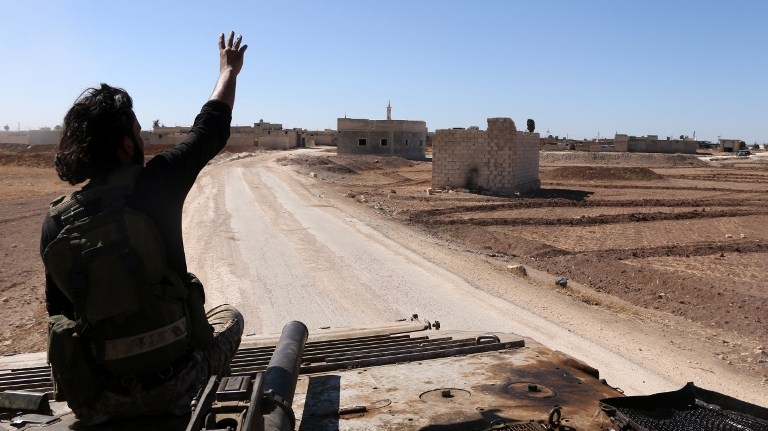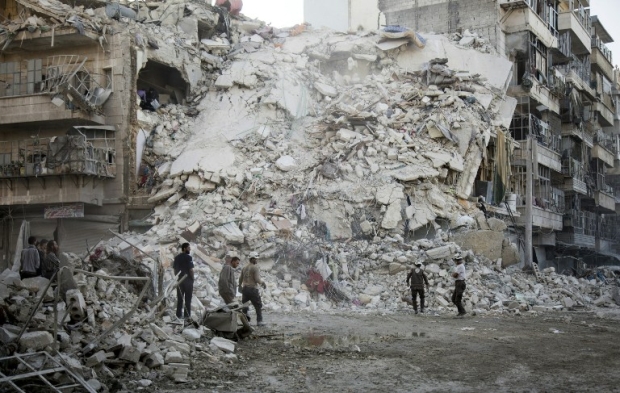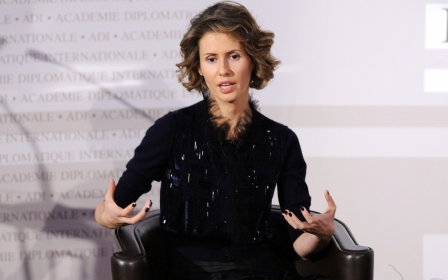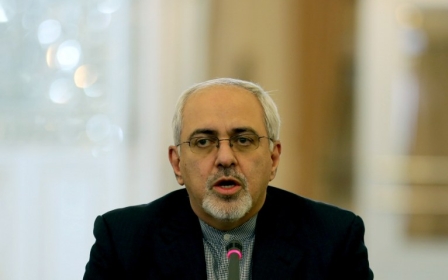A Syrian-American and Iranian-American’s message to their community about Syria

This past spring, the Muslim Public Affairs Council (MPAC) awarded Ben Rhodes, the White House’s deputy national security advisor, for his role in "articulating" the Obama administration’s peace agenda, most recently culminating in the Iran deal. Not uttered at all at the “Empowering Voices” gala was the word "Syria". That is what is to be expected from anyone looking for a "seat at the table" with the Obama administration.
Muslim advocacy groups in the US have left much to be desired when it comes to calling for more responsible foreign policy on Syria
We - a Sunni Syrian American and a Shia Iranian American with deep roots at home and abroad - fear that our president’s posture on Syria is leading to a future that is far more destructive than what the Nobel laureate had envisioned.
In the span of five years, our president has overseen the largest humanitarian disaster and refugee crisis since the Second World War and has set the stage for an even greater sectarian war between Islam’s two largest sects, Sunnis and Shias.
Syria can be saved. There are options. Yet Muslim advocacy groups in Washington and in the grassroots have left much to be desired when it comes to calling for more responsible foreign policy on Syria, and we ultimately remain divided on sectarian lines about how to resolve the worst humanitarian crisis in modern history.
Sectarian lenses
President Obama and others defending his policy of inaction have scoffed and regurgitated the notion that problems in the Middle East in general, especially those between Sunnis and Shia are “ancient” and not anything that America can have a role in fixing. We agree that only the Sunni and Shia communities can settle their own intra-faith disputes.
But we cannot play dumb and pretend that the continuum of US foreign policy - intervention in Iraq, inaction in Syria - does not play a role in stoking the flames of sectarianism and creating vacuums for extremism.
Now the Sunni Arab world must watch as Assad, his crony Russian and Shia allies Iran and Hezbollah besiege and massacre Syrians as the world stands idly by. The optics reflect the gravest strategic miscalculation in US foreign policy with the Muslim world of our generation.
We know as well as anyone that, in both of our respective communities, the conflicts in the Middle East are viewed through sectarian lenses, even by those closest to us. The evolving sectarian nature of the Syrian conflict can be attributed not only to Assad’s successful efforts to turn the Sunni majority and Alawis and, by extension, the Shias against each other, but also to the solidification of religious identities abroad.
That is despite the inclusive and pluralistic message of the Syrian Revolution since Day 1 in 2011. That message still needs to be heeded today.
Paranoia and passivity
Many Shia Muslims feel defensive over Assad’s actions because of the fear that the fate of the Shia world is tied to his. This is coupled with a deep paranoia stemming from historical grievances, especially among the Iranian community that the US is committed to undermining Iran, the vanguard of Shia Islam.
The landmark nuclear deal passed between the P5+1 and Iran helped ameliorate relations between the Washington and Tehran. Obama sought to preserve the delicate agreement with Iran by not intervening in Syria, other than ordering air strikes on the Islamic State (IS) group. His inaction in the conflict has translated into complicity in Assad’s slaughter of his own people. Shia Muslims’ passivity with Iran’s destructive involvement in Syria has done the same.
The international community is already bearing the humanitarian and military costs of allowing Assad to murder his own people. We are demanding that the US take action sooner rather than later to save countless numbers of lives, starting with the besieged Syrians in eastern Aleppo.
It will require military and diplomatic action. America can start by creating a humanitarian no-fly zone that grounds any Russian or Syrian warplanes attempting to bomb Aleppo. The next step is to push Iran to think of its own future.
Lobby for better policies
Resolving the Syrian conflict is an opportunity for Iran to demonstrate its interest in being a member of the international community, instead of a pariah.
The Assad regime will fall one day. The longer that Iran supports Assad, the greater the consequences will be for the Shia community around the world. The most effective method to mitigate sectarianism will be to recognise that Shias have a role to play in the resolution of the Syrian conflict.
It goes without saying, Iran’s participation will not excuse the damning role it played in prolonging the assault on Syrians. But as other Syrian American Muslims who met with Iranian President Hassan Rouhani have concluded, Iran, and by extension Shias, can play an instrumental role in bringing about Assad’s departure.
It is also hypocritical to harp about Sunni radical extremists like IS and offshoots of al-Qaeda without mentioning the thousands of Hezbollah fighters and countless Shia militias inside Syria killing innocent Syrians. This apathy encourages reciprocation, and stokes the fire of sectarianism. It is the type of message used by clerics in the Middle East and the Western world to engrain hatred of Shia among young Sunnis.
The fate of the Shia world must not rest in the bloody hands of the Assad regime. Shia Americans can control their own fate by denouncing the actions of the Syrian and Iranian government, and use their clout to lobby for responsible, humanitarian policies. At the very least, there must be solidarity with those who are oppressed.
During last week's commemoration of Ashoura, where the grandson of the Prophet Muhammad, Imam al-Husayn, was besieged and then massacred in Karbala for not pledging allegiance to a leader he saw as unfit, the silence about the siege and massacre of Aleppo was painfully symbolic.
Embrace the tapestry
The American Sunni community must similarly recognise the nebulous, historic co-optation and manipulation of Alawis and other minorities in Syria that began under Hafez al-Assad’s reign, as well as the diversity of opinion that exists in the Shia world.
There is nothing inherently religious about Iran’s involvement in Syria. It is, at the end of the day, political
While Iran uses historic Shia shrines in Syria as an excuse to send in thousands of militia forces, there is nothing inherently religious about Iran’s involvement in Syria. It is, at the end of the day, political.
It was not too long ago when Sunnis and Syria’s diverse minority groups celebrated each other’s holidays. Sunnis cannot play politics and turn a blind eye to Saudi Arabia’s war crimes in Yemen, despite the scale and varying dynamics of that conflict. Sunnis cannot condone Saudi Arabia’s - or your local imam’s - sectarian rhetoric.
To have seen the sectarian narrative take root and grow in the past five years is to have seen some of the various Muslim hubs in the US become very different, divided communities. This is but another layer to the rich, complicated tapestry of American Islam.
To paint Sunnis and Shias, Syrians or Iranians, or the Syrian Revolution with a broad brush, is to foster a generation of tribalism that will only normalise radical thinking.
The Quran - the holy book that both Sunnis and Shia share - states that “whoever kills a person, it is as though he has killed all mankind. And whoever saves a life, it is as though he had saved all mankind.” It is time for us to measure up to our shared values.
- Adham Sahloul is an advocacy officer with the Syrian American Medical Society, based in Gaziantep, Turkey. He has written about Syria previously for Lawfare, Middle East Eye, and The New Arab. You can follow him on Twitter at: @AdhamSahloul. Dina Yazdani is a Master’s student in Conflict Resolution in Divided Societies at King’s College London, and a Reporter for Fair Observer. You can follow her on Twitter @_DinaYazdani. Their views are their own.
The views expressed in this article belong to the author and do not necessarily reflect the editorial policy of Middle East Eye.
Photo: A rebel fighter sits atop an armoured vehicle near the village of Tilalayn on the western outskirts of the northern Syrian town of Dabiq on 16 October 2016 (AFP)
Middle East Eye propose une couverture et une analyse indépendantes et incomparables du Moyen-Orient, de l’Afrique du Nord et d’autres régions du monde. Pour en savoir plus sur la reprise de ce contenu et les frais qui s’appliquent, veuillez remplir ce formulaire [en anglais]. Pour en savoir plus sur MEE, cliquez ici [en anglais].






